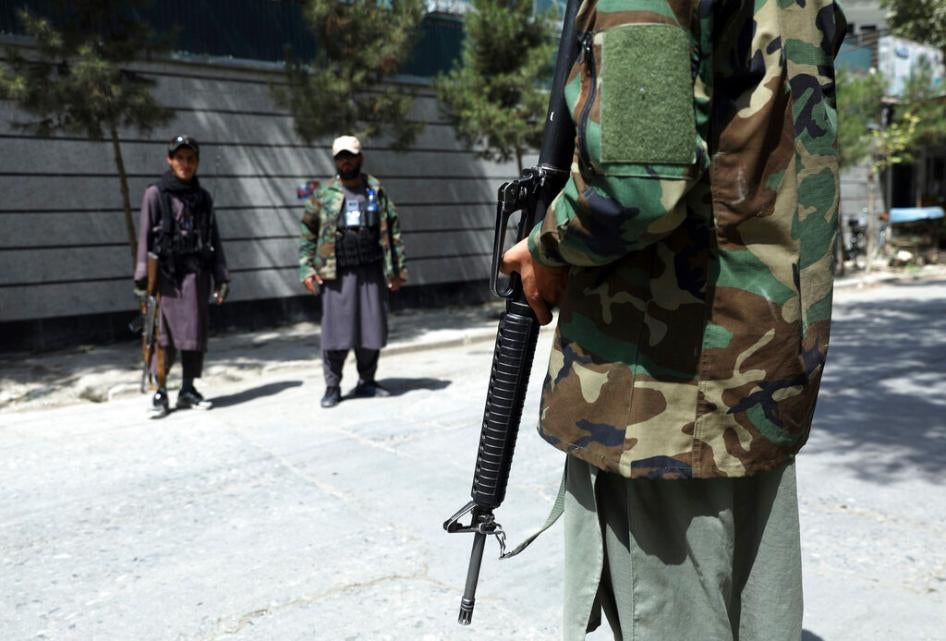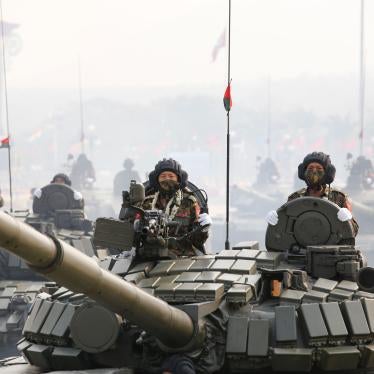For more than two decades, the Taliban have put children on the front lines of Afghanistan’s armed conflicts. They have used children as fighters, to plant and detonate improvised explosive devices (IEDs), and as suicide bombers. Thousands of children may remain in their ranks today.
The Taliban’s current efforts to establish a government in Afghanistan provide an opportunity for the international community to push for an end to child recruitment, and for the release of children from Taliban forces.
Taliban commanders long have relied on madrasas, or Islamic religious schools, to train and provide children as soldiers. Boys as young as 6 were indoctrinated, and by age 13, often had learned to use firearms. Children between 13 and 17 were often used to fight. Other parties to the conflict, including the U.S.-backed Afghan government and pro-government forces, reportedly also recruited and used children.
The Taliban used children to carry out suicide and other dangerous attacks, often recruiting them through deception, with promises of money or other incentives, and threats. One 15-year-old boy told United Nations investigators that a Taliban commander ordered him to detonate explosives against Afghan police, promising him that if he carried out the mission, he would go to paradise and receive “huge rewards.” When the boy resisted, the commander threatened to kill the boy and his parents.
Suicide attacks in Afghanistan were rare until 2005, but then were rapidly adopted as a war tactic by the Taliban and other insurgent groups. Since 2014, suicide attacks by Taliban forces have caused approximately 6,000 civilian casualties. Armed groups often use children to carry out such attacks because they are easier to manipulate and may be less likely to arouse suspicion than adults.
The conflict in Afghanistan has been one of the world’s deadliest for children — estimates are that approximately 33,000 children were killed or maimed over the past 20 years. The death toll among child soldiers can be particularly high. During a military offensive in Kunduz in 2015, for example, Human Rights Watch spoke with several families whose children, just 14 and 15, were killed in combat only weeks after the Taliban recruited them.
The Taliban have denied that they use children in “jihadic operations” and their code of conduct states that “boys without beards” are not allowed in military centers. Nevertheless, the U.N. has verified hundreds of individual cases in which the Taliban have recruited and used children in recent years, including a sharp spike in 2020, and warned that the true figures are likely much higher.
Crucially, the Taliban have demonstrated some sensitivity to accusations of child recruitment. In 2019, for example, the Taliban’s Commission for the Prevention of Civilian Casualties and Complaints secured the release of 14 boys from their ranks following community complaints.
The U.S.-backed former Afghan government and pro-government forces also bear responsibility for recruiting and using children to fight. In addition, the former government’s harsh treatment of children suspected of Taliban involvement most likely fueled anti-government resentment. Instead of providing children with rehabilitation assistance, as international law requires, security forces systematically detained and tortured hundreds of children — some as young as 10 — for suspected association with armed groups. U.N. investigations found that nearly 44 percent of children detained for conflict-related charges reported torture — a higher rate than for adult detainees. We do not know what has happened to these children.
During this time of transition, the international community should take several steps to help end the use of child soldiers in Afghanistan.
First, as the Taliban seek to establish themselves as the government, the U.N., donors and outside governments should raise the issue of child soldiers. Ending their recruitment and releasing children from their ranks could be a confidence-building measure and would demonstrate the Taliban’s willingness to comply with international norms.
Second, the U.N. Security Council should continue to support robust United Nations Assistance Mission in Afghanistan (UNAMA) monitoring of violations against children, including recruiting and using children in the Taliban ranks. For years, U.N. personnel have investigated and verified individual cases of child recruitment, providing important and incontrovertible evidence for advocacy with relevant authorities.
Third, individual commanders should be held accountable. The use of children under 18 in hostilities violates international law, and recruiting or using children under 15 is a war crime. The office of the prosecutor of the International Criminal Court has signaled its intention to investigate the recruitment and use of children in Afghanistan and should be supported. Prosecutions of individual commanders can send a strong signal — in Afghanistan and elsewhere — that child recruitment is unacceptable and carries significant consequences.
The Taliban’s record of human rights abuses is considerable, and there are many challenges ahead. But ending the exploitation of children on the battlefield should be a key condition in the anticipated negotiations between the Taliban and the international community.







